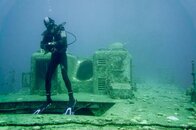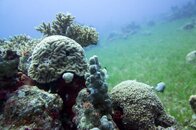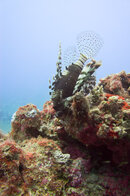(1)
http://www.lazyconv.com/galleries/DEMO/UW_TMP/DSC03375.ARW
The image shot at >20m with a wrong filter (FLD); this is the cause for excessive noise.
The noise isn't bad at all. I'll bet that if you made an 8"x10" print of that picture, you wouldn't need to bother with noise reduction. The picture is reasonably sharp, though. I ran it through LR "quick & dirty":

Processing:
WB temp: 20000
WB tint +150
Exposure: +2.0
Blacks -70
Clarity: +20
Some adjustment of the tone curve for the blue channel (one adjustment point 64%->47%, i.e. a concave curve shape)
Luminance noise adjustment: 25
Sharpening amount: 50 (to recover some lost acuity during noise reduction)
This picture isn't sharp. Looks primarily like motion blur even on the coral; work on holding the camera steady.

Processing:
WB temp: 10000
WB tint +150
Exposure: +0.70
Whites: +30
Blacks -20
Clarity: +20
Luminance noise adjustment: 0
Sharpening amount: 25 (LR standard)
(3)
http://www.lazyconv.com/galleries/DEMO/UW_TMP/DSC03665.ARW
Shot at 28.7m with FLB filter. Again, the color-balance of the main subject is mostly correct, and there is no excessive noise.
Again, not sharp. Looks like motion blur plus missed focus. Very difficult to color balance correctly in the foreground and avoid a magenta hue on the background, so I resorted to using an adjustment brush on the background water. Not very well, it's really quick&dirty.

Processing:
WB temp: 50000
WB tint +150
Exposure: +1.5
Luminance noise adjustment: 0
Sharpening amount: 25 (LR standard)
Adjustment brush on background, in auto mask mode: Temp -100, Tint -20
EDIT: If you're worried about digital noise, the last thing you want to do is to underexpose and then plus-compensate ("push") in post. That can make even a base ISO image look noisy. Try your best to get your pictures correctly exposed, and if that means you have to up the ISO, so be it. It's better than pushing in post. And stop pixel-peeping. Evaluate your pictures when they're downscaled for screen display, or as prints.
EDIT2: IMNSHO, if you're doing ambient light UW photography, you should try to make use of the hues and colors underwater, perhaps modifying the color balance somewhat to mimic our brain's auto color adjustment (it always looks worse in the camera than in our minds). That can give a very interesting look and feel, and you won't run into a brick wall trying for topside color balance. Because of the physics of light absorption, that's just not possible. If you want your reds and oranges to 'pop' like they do topside, you need artificial light.






